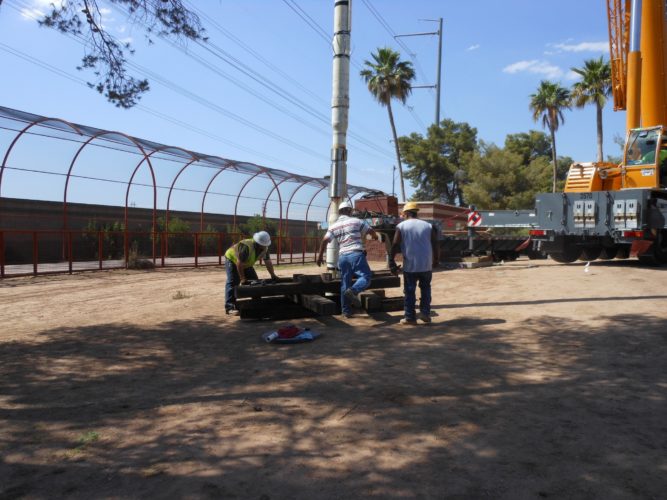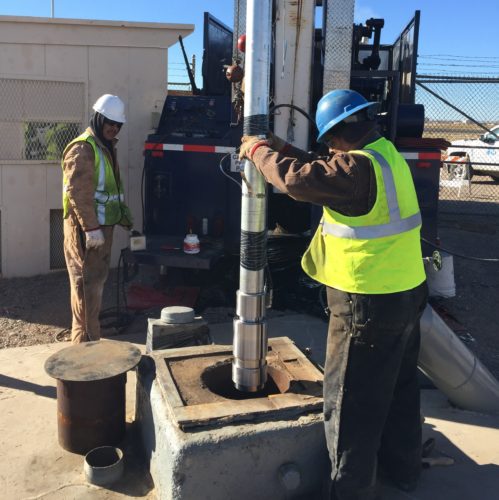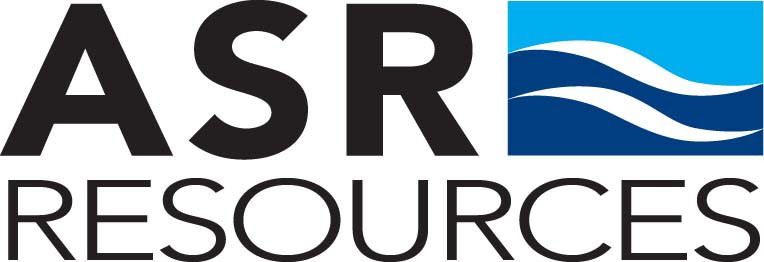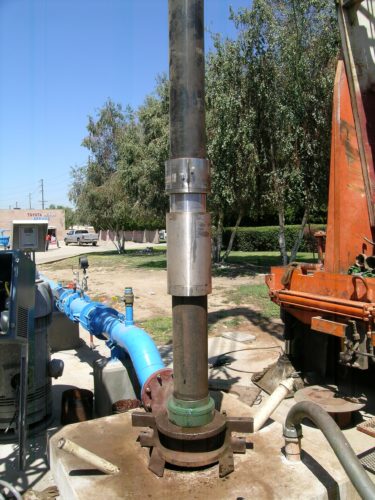Aquifer Storage and Recovery
Drinking/Potable Water The term Aquifer Storage and Recovery, or ASR, predominantly applies to municipal production wells that are set up for dual purpose, injection and pumping operation. The primary function of these wells is to supply potable water to a community. The secondary purpose is to allow treated water, meeting local and state regulations for potable water, to be injected back into the aquifer for extraction at a later date. Groundwater is replenished in times of suplus supply to allow for extraction at a later date. Typically this is with treated surface water, which is injected into the wells when there are seasonal fluctuations in supply to allow for the storage. Sometimes groundwater quality exceeds allowable limits for saline, arsenic and other components that cause a utility to pull a well out of production, or requires additional treatment above ground to bring the water into compliance for drinking water standards. Injected water can form a higher quality bubble in wells such as these to allow this higher quality water to then be extracted at a later date to eliminate the more expensive surface treatment options later. This allows marginal quality wells to remain in production

Reclaimed Waste Water Recharge
Rather than discharging treated effluent downstream of a treatment plant, local groundwater can be replenished by injecting effluent, treated to drinking water standards, back into the aquifer. Typically injection and extraction points differ in these applications so there is retention in the aquifer for a period of time before extraction, so that there is not a direct, immediate link to the extracted water coming immediately from the injection point.
Reclaimed Waste Water Recharge
Rather than discharging treated effluent downstream of a treatment plant, local groundwater can be replenished by injecting effluent, treated to drinking water standards, back into the aquifer. Typically injection and extraction points differ in these applications so there is retention in the aquifer for a period of time before extraction, so that there is not a direct, immediate link to the extracted water coming immediately from the injection point.

Sea Water Barrier
This typically utilizes the same waste water disposal techniques but in specific locations along the coastline to establish a “curtain effect” along the coast to prevent groundwater extraction from pulling in seawater due to over pumping. The injected water forms a “mound” or area of higher pressure to form a barrier between the fresh water aquifer and migrating water with higher salinity.


Brine Disposal
During desalination of water through reverse osmosis, there is a brine waste stream that must be disposed of. Regulations prevent surface discharge and limit or prohibit the amount and/or locations that this brine can be disposed into the ocean. A brine disposal well injects this high saline content water into deeper aquifers or other brackish water aquifers that are not use for drinking water supply.
Brine Disposal
During desalination of water through reverse osmosis, there is a brine waste stream that must be disposed of. Regulations prevent surface discharge and limit or prohibit the amount and/or locations that this brine can be disposed into the ocean. A brine disposal well injects this high saline content water into deeper aquifers or other brackish water aquifers that are not use for drinking water supply.

Groundwater Remediation
Contaminated groundwater is extracted from an identified plume and delivered for a specific treatment process based on the contaminates that need to be removed. Generally the extraction wells are located on the most hydraulically down-gradient boundary of the contaminant plume. The injection wells are typically separate wells, located on the most hydraulically up-gradient boundary of the plume. Once treated, the water is re-injected back into the aquifer, through the V-Smart BIC-V™ valve in a continuous pump/treat/inject process to slowly bring the contaminated aquifer back into safe water quality standards. Most of these wells are equipped with submersible pumps to allow for backlashing of the injection well after a pre-determined length of time to remove any clogging mechanisms that can degrade the injection performance of the wells. Most often, the extracted backflush water is delivered back into the treatment system in a closed loop process. Although designed as injection wells without recovery pumping demands, the V-Smart BIC-V™ valve functions in the dual purpose role, allowing for water to be injected through the injection ports and then during backflush pumping, with flow back up through the center of the valve.


Vadose Zone Wells
The vadose or “shallow” zone is the unsaturated portion of the subsurface that lies above the saturated zone also know as the groundwater table or aquifer. This vadose zone is located above the aquifer and extends all the way up to the surface.
The vadose zone affects the natural percolation of water from the land surface to the aquifer during natural recharge through rainfall. The most common use of the vadose zone for artificial recharge is through infiltration basins and typically involves the use of storm-water or treated effluent flows. The recovery and reuse of non-potable treated effluent has become more important to municipalities who utilize recharge systems in order to replenish groundwater basins affected by over drafting of these basins, especially during drought years when surface water resources don’t keep up with demand. These basins, however take up a good amount of surface area to achieve the necessary infiltration rates.
Vadose Zone recharge wells require much less land surface for installation than infiltration basins. In these applications, the effluent is treated to injection permit requirements and pumped to these recharge wells from an adjacent wastewater treatment plant. The injected treated effluent is then subject to soil aquifer treatment and improved quality as it percolates down to the saturated zone to replenish the groundwater.
The V-Smart BIC-V Borehole Injection Control Valve™️ plays a key role in the effectiveness of these vadose zone wells. Although vadose zone wells are typically considerably less expensive to
Vadose Zone Wells
The vadose or “shallow” zone is the unsaturated portion of the subsurface that lies above the saturated zone also know as the groundwater table or aquifer. This vadose zone is located above the aquifer and extends all the way up to the surface.
The vadose zone affects the natural percolation of water from the land surface to the aquifer during natural recharge through rainfall. The most common use of the vadose zone for artificial recharge is through infiltration basins and typically involves the use of storm-water or treated effluent flows. The recovery and reuse of non-potable treated effluent has become more important to municipalities who utilize recharge systems in order to replenish groundwater basins affected by over drafting of these basins, especially during drought years when surface water resources don’t keep up with demand. These basins, however take up a good amount of surface area to achieve the necessary infiltration rates.
Vadose Zone recharge wells require much less land surface for installation than infiltration basins. In these applications, the effluent is treated to injection permit requirements and pumped to these recharge wells from an adjacent wastewater treatment plant. The injected treated effluent is then subject to soil aquifer treatment and improved quality as it percolates down to the saturated zone to replenish the groundwater.
The V-Smart BIC-V Borehole Injection Control Valve™️ plays a key role in the effectiveness of these vadose zone wells. Although vadose zone wells are typically considerably less expensive to install, they can also experience clogging events that are more difficult to correct. Since vadose zone wells do not have backwash pumps installed, protecting the well against clogging becomes critically important. Injection flow rates are typically less than those of similar size saturated zone injection wells. Although located in the non-saturated zone, the same clogging mechanisms can exist in vadose zone wells as in saturated zone wells. For this reason, the careful control of flow into the vadose zone wells becomes critical to keep the water from reaching land surface and to prevent cascading water which leads to air entrainment and the resulting air binding and mineral precipitation that leads to clogging

Aquifer Thermal Energy Storage
Aquifer thermal energy storage (ATES) is an fairly recent open geothermal technology for the seasonal storage of cold and/or warm groundwater in an aquifer for recovery of thermal energy in the subsurface. ATES is applied to provide heating and cooling to buildings or other industrial facilities such as power generation or manufacturing plants. The technology was developed in Europe over 25 years ago, with installations exceeding 1,000 location in Netherlands and Scandinavia, but has only recently started seeing acceptance and use in the US. In the US, a traditional geothermal system utilizes the groundwater’s usually consistent and stable temperature to provide heat energy in the winter and cooling energy in the summer. But with ATES, an aquifer is used to store energy rather than only extracting energy from it. Through the by extraction and injection of groundwater from aquifers, recovery of thermal energy is achieved using groundwater wells. ATES requires a suitable aquifer (subsurface geology), into which at least two separate thermal wells are installed, a cold well and a warm well. ATES systems will usually operate on a seasonal basis. The cool groundwater that is extracted in summer, is passed through a heat exchanger for cooling by transferring heat from the building to the groundwater. During the process, the heated groundwater is injected back into the aquifer for storage of heated groundwater. The flow direction is reversed during the winter allowing the heated groundwater to be extracted and used for heating through a heat pump. The operation of an ATES system uses the aquifer to temporarily store the process water to handle some or all of the location’s heating and cooling demand.
The V-Smart BIC-V Borehole Injection Control Valve™️ is utilized on these wells to control flow into the aquifer in similar fashion to other aquifer storage and recovery applications to control the

Aquifer Thermal Energy Storage
Aquifer thermal energy storage (ATES) is an fairly recent open geothermal technology for the seasonal storage of cold and/or warm groundwater in an aquifer for recovery of thermal energy in the subsurface. ATES is applied to provide heating and cooling to buildings or other industrial facilities such as power generation or manufacturing plants. The technology was developed in Europe over 25 years ago, with installations exceeding 1,000 location in Netherlands and Scandinavia, but has only recently started seeing acceptance and use in the US. In the US, a traditional geothermal system utilizes the groundwater’s usually consistent and stable temperature to provide heat energy in the winter and cooling energy in the summer. But with ATES, an aquifer is used to store energy rather than only extracting energy from it. Through the by extraction and injection of groundwater from aquifers, recovery of thermal energy is achieved using groundwater wells. ATES requires a suitable aquifer (subsurface geology), into which at least two separate thermal wells are installed, a cold well and a warm well. ATES systems will usually operate on a seasonal basis. The cool groundwater that is extracted in summer, is passed through a heat exchanger for cooling by transferring heat from the building to the groundwater. During the process, the heated groundwater is injected back into the aquifer for storage of heated groundwater. The flow direction is reversed during the winter allowing the heated groundwater to be extracted and used for heating through a heat pump. The operation of an ATES system uses the aquifer to temporarily store the process water to handle some or all of the location’s heating and cooling demand.
The V-Smart BIC-V Borehole Injection Control Valve™️ is utilized on these wells to control flow into the aquifer in similar fashion to other aquifer storage and recovery applications to control the injection flow rate to designed rates, preventing air entrainment and well clogging, while controlling water level rise in the well bore. The customized injection ports on the valve allow for precise control to maintain consistent, repeatable set points for optimal flow rates.


